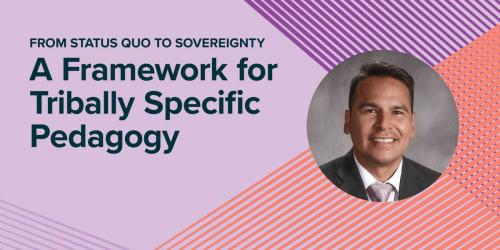Improving the Identification of Native Students at the University of Oregon

During the 1990s, the University of Oregon (UO) made a commitment to better serve the needs of its American Indian/Alaska Native (AI/AN) students. The first issue we faced was the most fundamental: How do we accurately identify these students?
By U.S. Government standards of tribal enrollment, only individuals who meet the enrollment rules set by a federally recognized tribe are eligible for federal benefits (including educational resources). At the same time, any college student who self-identifies as AI/AN on the admissions questionnaire is considered to be AI/AN. This, too, is a federal standard.
The inherent problem for universities is that these two federal standards are contradictory. If all 567 tribal nations have sovereign domestic government status and their citizens are eligible for education resources, then why don’t universities require proof of citizenship? In practice, self-selection in higher education produces a fake reality and actually impedes our ability to serve AI/AN students.
Addressing this issue has been a long journey. In 1995, under President Dave Frohnmayer, the UO established its Native American Advisory Council (NAAC), which began asking difficult questions regarding how many AI/AN students were attending the UO and from what tribes. At the time, the university relied solely on students’ responses on the admissions questionnaire, which allowed them to self-identify as AI/AN without any proof of tribal citizenship. Essentially, this process addressed the broad federal standard for race identification without consideration of the very narrow federal standard for AI/AN citizenship. Not surprisingly, the NAAC’s inquiry into this process revealed a major discrepancy: Most students who self-identified as AI/AN were not citizens of a federally recognized tribal nation.
In 2007 this issue was further complicated by new federal guidelines about who could be counted as AI/AN. Under these guidelines, if a student was AI/AN but also Latino, by default they would be listed only as Latino. A student who was AI/AN and black (or in combination with any other race except Latino) would be listed as multiracial. In fact, the only way to be counted as AI/AN was to select AI/AN and no other races.
As a result of the federal government’s decision to homogenize “identity or race” designations, AI/AN student enrollment numbers plummeted on virtually every campus in the country, while Latino enrollment numbers rose dramatically. In addition, many AI/AN students were only identified as multiracial, thereby missing out on educational resources for which they were qualified. Meanwhile, the problem of self-identification remained unaddressed.
A New Process for Improving Identification of American Indian and Alaska Native Students
In 2014, UO made a calculated decision to focus on tribal citizenship as a way to address these issues. On the new application questionnaire, when a potential student selects AI/AN they are prompted to select one of the 567 federally recognized tribes. While this process does not eliminate the federal race/ethnicity issue (an AI/AN student who is also Latino or multiracial is still processed according to federal race accounting standards) at the very least, we can identify all AI/AN citizens and ensure they get the resources for which they are qualified.
We took this process one step further by asking students for their tribal enrollment number. And for students who are not citizens of a federally recognized tribe, the questionnaire asks, “Do you have a federally issued Certificate Degree of Indian Blood card or are you a descendent of an AI/AN enrolled citizen?”
Better Serving Students and Improving Accountability to Tribes
By focusing on citizenship within a specific tribal nation we are better able to serve our AI/AN students. In our view, you cannot provide services that tribal citizens need or want if you do not have a relationship with the tribe itself. At UO, each AI/AN student serves an ambassador for their tribe. Meanwhile, as assistant vice president and advisor to the president for government-to-government relations, I am responsible for communicating directly with tribal representatives.
This process has greatly improved our relationship with the tribes, while also ensuring that students get the appropriate resources and support they need. Historically, AI/AN students have faced tremendous challenges to enrolling in college and completing a degree. By accurately identifying these students and working directly with tribes, we are removing as many barriers as possible.
Jason T. Younker, Ph.D., is the Assistant Vice President and Advisor to the President on Sovereignty and Government-to-Government Relations at the University of Oregon and a member of the Coquille Indian Tribe.



